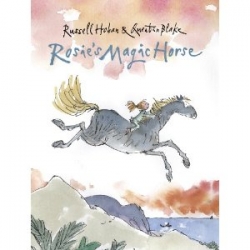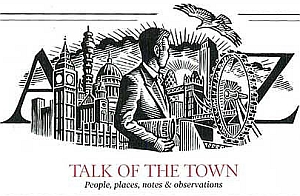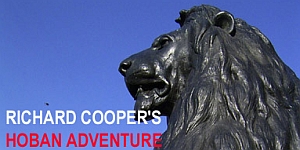The British Museum
(The Lion of Boaz-Jachin & Jachin-Boaz; Schwartz)
Having navigated the choppy seas of Tottenham Court Road, I came to the junction with Oxford Street and decided to cross over for a quick diversion into Foyles in the northern end of Charing Cross Road before I went to the British Museum. Before Waterstone’s bought the famous Simpson’s department store in Piccadilly a few years ago, Foyles was the biggest bookshop in London and was the definitive place to go for all your literary needs. However, I was disappointed to find very little in the way of Hoban on their shelves – only the paperback of Lion and a few of the Frances books in the children’s section. Across the road from Foyles meanwhile was Borders, which I hadn’t been to before. I didn’t like the décor or the lighting much, but at least they had a copy of just about all the currently in-print Hoban titles. Just past Borders was Denmark Street, where I stopped for a moment to satisfy the guitarist in me. The British Museum was a short walk around the titanic Centre Point tower building and up New Oxford Street, past rows of shops selling computers and general technology in an apparent extension of Tottenham Court Road. I passed a BUREAU DE CHANGE which had a sign in the window saying NO COMMOSSION, cut through Little Russell Street and the fantastically-named Coptic Street into Great Russell Street, and found the museum sitting in a huge cobbled square behind black iron railings. The British Museum is a classic misnomer, containing as it does nothing strictly British but rather vast collections of artefacts from all over the ancient world. Indeed, the building itself looks as if it might have been brought in brick by brick from ancient Greece.
My first stop was to see the bas-reliefs from the Assyrian temples depicting King Ashirbanipal’s lion hunt, which provided much of the inspiration for The Lion of Boaz-Jachin and Jachin-Boaz. Lions in fact seemed to be a theme throughout the museum, starting from the drinking fountain at the entrance. I bought a paper guide to the museum for £2 and asked a human guide the way to the room. The bas-reliefs had been mounted on the walls of two narrow rooms and, lit in very subtle fashion, were themselves curiously lion-coloured. With the incredible attention paid to the detail of the lions’ bodies and faces, it was like walking into a temple erected to the tragedy and braveness of the lions who had died during this distasteful royal sport. The king and his cohorts were all literally two-dimensional, as if they were more symbolic than representative of individuals, but the lions had real depth of character and lived on within the cool, quiet, tawny walls of the museum. I took the quote I’d chosen for this location, folded it in half and laid it over the barrier rope.
The second item I wanted to look at was also a lion, the black stone temple-guardian from the lovely short story Schwartz from The Moment under The Moment:
I walked through into the enormous central hall of the museum and was guided to Oriental Antiquities. A general survey of the room revealed no obvious black stone lions which might have been large enough to be temple-guardians, so, thinking I might not be using my imagination sufficiently, I hunted for a smaller lion among the display cases of Buddhas, monks, gods, animals, animal-gods, ornaments, drinking vessels and any number of other beautiful artefacts from the Ancient East, all the time wondering how I might be able to distract the gallery attendants for long enough to play the lion a bit more Thelonious Monk. However, even a thorough search couldn’t turn up Schwartz in the flesh, or even in the stone; perhaps he really had walked out of the museum with the narrator of the story and decided he liked Tottenham Court Road so much that he never went back. But that was just being silly: surely he had to be here somewhere. I approached an attendant sitting in a corner reading a paperback; he had long hair tied back in a ponytail and a long face with interesting teeth. “I’m looking for a black stone Chinese lion,” I said to him.
“A black stone Chinese lion...” he repeated, his eyes narrowing.
“I read about it in a story written a few years ago.”
“Well,” he said, “I’m not aware of one... but if you like I’ll look along this side of the gallery and if you want to look along the other side...”
So the two of us took sides in the matter and roved in parallel formations up the gallery like commandos creeping through the jungle, bracing ourselves for ambush by Schwartz. I half expected us to bump into each other walking backwards and then swing around to face each other in terror like a clumsy duo in some old black and white comedy, but instead we met up in quite civilised fashion at the other end of the hall along with several other gallery attendants, standing around in their uniforms like a meeting of the Salvation Army. “Nothing?” I said.
“Nothing, I’m afraid,” said my attendant.
“What are you after?” said one of the other attendants with a gorblimey accent.
“He’s looking for a black stone lion,” said my attendant.
“A black stone lion?” said Sgt. Gorblimey, and they all ummed and aahed for a few moments.
“He read about it in a book,” said my attendant.
“Ahh,” said one of the others.
“It was a temple-guardian,” I said, “so it must have been quite big.”
“A temple-guardian, you say?” said Gorblimey. “Mmmm...”
“The story was written about twenty years ago,” I explained, “so maybe it’s just not here anymore.”
“That’s probably what happened,” said the sergeant.
“Things do move about,” said another attendant.
“They come and go,” concurred another.
“Well, no worries,” I said. “Thank you for your help.”
“You’re welcome.”
So that seemed to be it – there were no black stone lions anymore. Well, not in the British Museum, anyway.
On the way out I made a visit to the toilet. On the hand-dryers were the manufacturer’s name and their address given as “Barcelona, Spain”. Someone had scribbled out “Spain” and written “Catalonia” instead.










 On 4 February 2012 the Slickman A4 Quotation Event celebrated
On 4 February 2012 the Slickman A4 Quotation Event celebrated 


 In 2005 the first international convention for Russell Hoban fans took place in London, and was marked by the publication of a fantastic 48-page booklet featuring exclusive contributions from innumerable fans and associates including novelist David Mitchell and actress Glenda Jackson. A wonderful memento of the event, it's also a beautiful collector's item and must-have for any Hoban fan. Although in limited supply, copies of the booklet are still available at £6.00 each plus p&p. Order direct from
In 2005 the first international convention for Russell Hoban fans took place in London, and was marked by the publication of a fantastic 48-page booklet featuring exclusive contributions from innumerable fans and associates including novelist David Mitchell and actress Glenda Jackson. A wonderful memento of the event, it's also a beautiful collector's item and must-have for any Hoban fan. Although in limited supply, copies of the booklet are still available at £6.00 each plus p&p. Order direct from  Russell Hoban turned 86 on 4 February 2011 and fans celebrated in traditional style by leaving quotes from his books in public places. Browse their quotes
Russell Hoban turned 86 on 4 February 2011 and fans celebrated in traditional style by leaving quotes from his books in public places. Browse their quotes  To celebrate 30 years in print of Russell Hoban's most famous novel
To celebrate 30 years in print of Russell Hoban's most famous novel 






No comments:
Post a Comment
Note: only a member of this blog may post a comment.